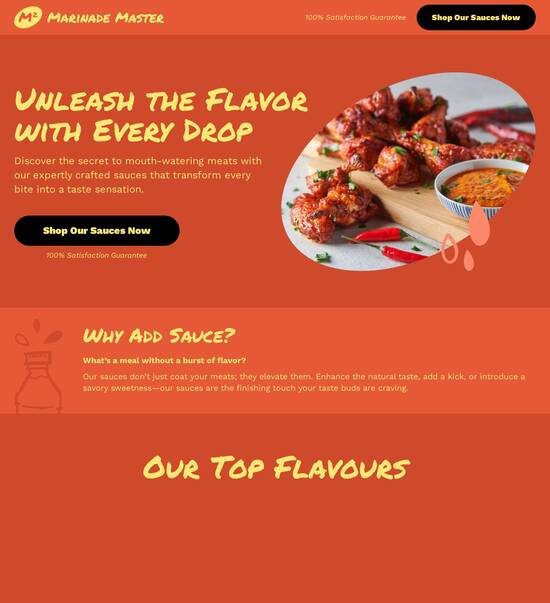
HTML page template with interactive market segmentation survey
Explore Similar TemplatesAbout template
Use HTML page templates with interactive market segmentation survey and make your communications easy and transparent. Try our solution today.
Recommended templates

Easy to build without coding
With the intuitive drag-and-drop builder, anyone on your team can create high-converting pages without any knowledge of code or design. Make enhancements to your landing page with custom widgets using Javascript, HTML/CSS, or third-party scripts.

Multiple layouts for any industry and goal
Select from 500+ landing page layouts built to boost conversions across industry-specific scenarios. Customize them by adjusting fonts, adding images, and generating on-brand content with the AI assistant. Quickly scale with Instablocks® and Global Blocks that you can save, reuse, and update globally.

Loads fast and looks polished on any device
Every template is responsive, which means they present professionally on any device and load blazingly fast with our Thor Render Engine. You can also power them up with Google AMP technology to deliver an unparalleled mobile experience and drive higher conversions.

Robust analytics & experimentation
Get real-time updates and reporting across all your devices, showing the number of visitors, conversions, cost-per-visitor, and cost-per-lead. Launch AI-powered experiments, run A/B tests, and use heatmaps to analyze user behavior, then optimize your landing page to maximize conversions.







Easy to build without coding
With the intuitive drag-and-drop builder, anyone on your team can create high-converting pages without any knowledge of code or design. Make enhancements to your landing page with custom widgets using Javascript, HTML/CSS, or third-party scripts.
Multiple layouts for any industry and goal
Select from 500+ landing page layouts built to boost conversions across industry-specific scenarios. Customize them by adjusting fonts, adding images, and generating on-brand content with the AI assistant. Quickly scale with Instablocks® and Global Blocks that you can save, reuse, and update globally.
Loads fast and looks polished on any device
Every template is responsive, which means they present professionally on any device and load blazingly fast with our Thor Render Engine.
Robust analytics & experimentation
Get real-time updates and reporting across all your devices, showing the number of visitors, conversions, cost-per-visitor, and cost-per-lead. Launch AI-powered experiments, run A/B tests, and use heatmaps to analyze user behavior, then optimize your landing page to maximize conversions.
All the features you need to build market segmentation template
Explore more featuresLearn how to build market segmentation survey templates
Frequently asked questions about customer segmentation template
Leading the way in building high-performing landing pages





A comprehensive guide to using Instapage for high-converting landing pages
Landing pages play a crucial role in digital marketing campaigns, and leveraging an advanced platform like Instapage can significantly enhance your ability to convert visitors into leads. With its powerful tools and features, Instapage empowers marketers across various industries, including education, tech/SaaS, and financial services, to optimize their landing pages and maximize ROI.
Understanding the basics of landing pages
Creating effective landing pages involves more than just design; it requires strategic planning and execution. Instapage offers over 100 customizable templates that are specifically designed to increase conversion rates. These templates are equipped with essential lead generation elements, enabling you to capture visitor information effectively.
- Accessibility: Ensure your landing pages are mobile-friendly and available across all devices.
- Visual appeal: Use high-quality images and compelling copy to create an engaging user experience.
- Call-to-action: Incorporate strong and clear calls-to-action that motivate visitors to take the desired action.
The importance of optimization for higher conversions
To boost the effectiveness of your landing pages, Instapage provides built-in optimization features. These allow you to experiment with different elements and analyze user behavior through detailed heat maps, leading to data-driven decisions that refine your marketing strategies.
Personalization: Delivering tailored experiences
Personalization in digital marketing is key to connecting with your audience on a deeper level. Instapage’s dynamic text replacement feature allows you to customize your content based on individual user data, creating unique and relevant promotional experiences. Additionally, the use of AdMaps aligns your ads to specific landing pages, ensuring your visitors encounter consistent messaging throughout their journey.
- Dynamic content: Automatically change the text and images on your landing pages based on visitor demographics.
- Segmentation: Use audience data to better target your messaging and increase engagement.
- Performance tracking: Evaluate how personalized pages perform against standard pages to optimize your approach.
Collaboration tools that enhance productivity
Effective collaboration among teams is essential in streamlining the landing page creation and review process. Instapage comes equipped with features that facilitate real-time edits, instant feedback, and secure sharing, making it easy for teams to work together, regardless of location.
- Real-time feedback: Allow team members and stakeholders to provide comments directly on the page.
- Version control: Keep track of changes and revert to previous versions if necessary.
- Easy sharing: Distribute your landing pages for review with a simple link, eliminating the need for complicated email chains.
Ultimately, the combination of optimization, personalization, and collaboration tools provided by Instapage makes it the ideal platform for marketers looking to create effective landing pages that drive conversions.
Ready to enhance your digital marketing efforts? Start creating high-converting landing pages with Instapage today to maximize your ROI and effectiveness.
HTML page template with interactive market segmentation survey
Understanding market segmentation and its importance in marketing
Market segmentation is a critical component of effective marketing strategies. By dividing a broad target market into subsets of consumers with common needs or characteristics, businesses can tailor their marketing messages to resonate more deeply with specific groups. This approach allows companies to allocate their marketing resources more efficiently, ultimately leading to improved engagement and conversion rates.
Effective market segmentation helps brands connect with consumers on a personal level. By understanding who their customers are and what drives their decisions, marketers can craft campaigns that speak to the unique desires and motivations of each segment. This not only enhances overall customer satisfaction but also strengthens brand loyalty over time.
Increased targeting precision—businesses reach the right audience.
Heightened competitive advantage through specialized messaging.
Improved market insight for anticipating consumer needs.
Types of market segmentation
There are several primary types of market segmentation, each focusing on different aspects of consumer behavior and preferences.
Demographic segmentation
Categorizing consumers based on age, gender, income, and education level helps brands to tailor their offerings and marketing messages.
Geographic segmentation
Understanding how location impacts customer preferences can significantly influence product availability and marketing approach.
Psychographic segmentation
This type analyzes consumer lifestyles, values, and personality traits, facilitating deeper emotional connections to marketing campaigns.
Behavioral segmentation
Focuses on purchasing patterns, brand loyalty, and readiness to buy, allowing marketers to engage consumers with timely and relevant offers.
The role of an interactive market segmentation survey on HTML pages
An interactive market segmentation survey can significantly enhance data gathering and consumer engagement. Unlike standard forms, interactive surveys encourage higher engagement rates and provide instant feedback, allowing brands to collect valuable consumer insights in real-time.
By incorporating dynamic elements and user-friendly interfaces, these surveys create an immersive experience that keeps participants involved. When users feel that their feedback is valued and yields immediate benefits, they are more likely to complete the survey, helping businesses to gather comprehensive data on their target markets.
Encourages higher engagement rates through interactivity.
Allows for real-time data collection, adapting to user needs.
Enhances the user experience, contributing to longer dwell times.
Crafting the HTML page template
Design best practices are essential when creating an HTML page template for an interactive market segmentation survey. A responsive design ensures that content appears seamlessly on various devices, providing a uniform experience for all users. It is crucial to make sure that the template is visually appealing while also functional, as it directly influences user interaction and survey completion rates.
Furthermore, compelling callouts, such as attention-grabbing visuals or strategic positioning of survey prompts, guide users toward participation. Incorporating principles of color psychology and branding can enhance emotional responses, creating an inviting atmosphere that encourages users to engage with the survey.
Responsive design that adapts to all devices.
Strong visual elements for guiding users toward the survey.
Thoughtful color choices to evoke the desired emotional response.
Technical implementation strategies
To successfully implement an interactive market segmentation survey, an understanding of HTML and CSS fundamentals is required. These coding languages form the basis for creating a smooth and attractive user experience. Proper structure and styling ensure that users navigate the survey with ease, minimizing friction points that could deter completion.
JavaScript plays a significant role in enhancing interactivity. It empowers the survey to respond in real-time to user inputs, making adjustments to subsequent questions based on previous responses. This dynamic questioning approach not only keeps the survey relevant but also personalizes the experience for each participant, increasing the likelihood of capturing accurate data.
Implement HTML and CSS for creating responsive layout and visuals.
Use JavaScript to enable interactive features and dynamic questioning.
Incorporate accessibility features to meet diverse user needs.
Use cases of market segmentation surveys
Various companies have effectively utilized market segmentation surveys to hone in on their target audiences. These case studies illustrate successful segmentation efforts that led to tailored marketing strategies and improved customer satisfaction. For instance, a leading retail brand adjusted its product offerings based on survey insights, resulting in a notable increase in sales and customer loyalty.
In addition, understanding distinct consumer segments drives product development and overall brand strategy. Companies that analyze behavioral data can discover emerging trends and adapt their offerings accordingly. Focusing on targeted marketing based on well-defined audience segments has allowed many businesses to optimize their campaigns and experience substantial growth.
Case studies showcasing successful surveys and resulting marketing strategies.
Insights into consumer-driven product development.
Analysis of targeting techniques employed for segmentation.
The benefits of targeting with market segmentation
Targeting distinct market segments can enhance marketing resource efficiency. By concentrating marketing efforts on specific groups, companies can avoid wasted spending on broad campaigns that may not appeal to everyone. Quantitative analyses often reveal that businesses leveraging segmentation see improved conversion rates and better returns on investment.
Furthermore, tailoring messages to meet the specific needs of different segments helps build stronger customer relationships. As marketing becomes more relevant and beneficial to consumers, trust and loyalty naturally develop, leading to a more sustainable customer base over time.
Optimized marketing spend resulting from targeted campaigns.
Stronger customer relationships through personalized messaging.
Agility in adapting to shifting consumer preferences.
Conclusion through execution
To effectively integrate interactive surveys into marketing campaigns, companies should adopt best practices from the outset. Ongoing analysis and optimization of collected data is vital for continued success, as consumer needs are always changing. Businesses that prioritize data-driven decision-making and nimbleness in their marketing outreach will stay ahead of the competition.
Looking forward, the integration of advanced technologies like AI and machine learning will likely transform market segmentation strategies even further. Enhanced consumer insights resulting from these developments will enable marketers to fine-tune their approaches and anticipate market shifts proactively, setting the foundation for future success.
Importance of data-driven decision-making in marketing strategy.
Potential impact of AI and machine learning on marketing segmentation.
Continuous learning and adapting to marketplace changes.
Ensuring long-term engagement
To maximize the value of survey data beyond initial collection, businesses must develop strategies for continual refinement of marketing efforts. This includes periodically reassessing segments as consumer interests evolve over time. A commitment to understanding and reacting to customer feedback is essential to maintaining relevance and engagement.
Integrating segmentation data with customer journey mapping can lead to deeper insights into user behavior. This combination provides clarity on how to optimize marketing strategies at every consumer touchpoint, ensuring that businesses meet evolving demands and preferences effectively.
Leverage survey data to continuously refine marketing strategies.
Create a holistic view of customer journeys to enhance engagement.
Establish a system for monitoring market trends and adjusting accordingly.
Ready to skyrocket conversions?
Supercharge your ad campaigns with high-performing landing pages
Get started














